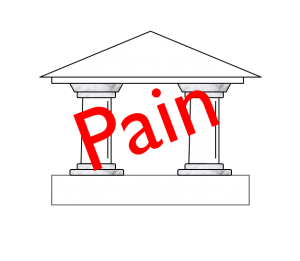 We’re all familiar with the Toyota Production System “house.” You know, the structure schematic with, among other things, the just-in-time and jidoka pillars.
We’re all familiar with the Toyota Production System “house.” You know, the structure schematic with, among other things, the just-in-time and jidoka pillars.
Well, sometimes I think it would be more appropriate to refer to the house, any lean house, as a house of pain.
What?!?
Not great for lean marketing purposes, necessarily. But, there is more than a bit of truth to this notion of lean pain.
Here we’re not talking about pain in some sort of sadistic or masochistic way. This type of pain is value-added in that it spurs quick recognition and meaningful response to stop that particular pain forever…all for the purpose of making things easier, better, faster, and cheaper.
Sure, we could try to avoid pain. Most normal people don’t like pain. But, as the old cliché goes, “No pain, no gain.” And by gain, we mean continuous improvement and organizational learning.
So, what is a primary building block (pillar, foundation, etc.) of this house of pain?
I’m thinking continuous flow (it’s part of the just-in-time pillar, by the way) is a great candidate, among many. There’s nothing quite like operating with a lot size of one. Continuous flow provides no place to run OR hide.
It will never be mistaken as a morphine replacement.
Of course, lean’s pain is somewhat compassionate, in a big picture sort of way. It does not seek to kill or incapacitate. That would NOT be value-added.
How could you possibly satisfy the customer in such a condition?! How would that square with respect for the individual?
So instead, lean’s pain is more gradually and strategically applied. As an example, we strive for continuous flow, but often the more pragmatic (and temporary) approach includes a measure of supermarket pull and/or sequential pull (a.k.a. FIFO lanes). For a batch-and-queue operation, that’s pain enough…for now.
This isn’t quite Shewhart-esque or Deming-esque, but the lean pain cycle might go something like the following:
- Enable/facilitate pain - for example, implement continuous flow.
- Recognize the pain when it comes (and it will come, if you're appropriately aggressive) – visual controls are critical for early recognition.
- Respond to the pain – think line stop jidoka, along with andon response.
- Make the specific pain go away – first aid may be more along the lines of containment, but permanent pain elimination requires real problem solving.
- Repeat.
[LSS Academy's and Gemba Academy's Ron Pereira shared an excellent video a while back that explained the true meaning of the Chinese characters constituting the word “kaizen.” In all seriousness, it has something to do with self-flagellation, sheep, and altars! True story. The subject of pain is definitely front and center. Go here to see Brad Schmidt’s expert and very entertaining explanation.]
Here’s another cliché, “What doesn’t kill you, makes you stronger.”
Which raises an important point – the lean leader needs to understand pain thresholds (without facilitating lean wimpiness) and challenge and coach others appropriately.
Here's to value-adding pain!
Related posts: 12 Narrow Lean Gates, Standard Work Is Like Food – Taste before Seasoning, Leader Standard Work Should Be…Work!
